Rodecaster Duo & Rode PodMic USB Review: On the Rode Again
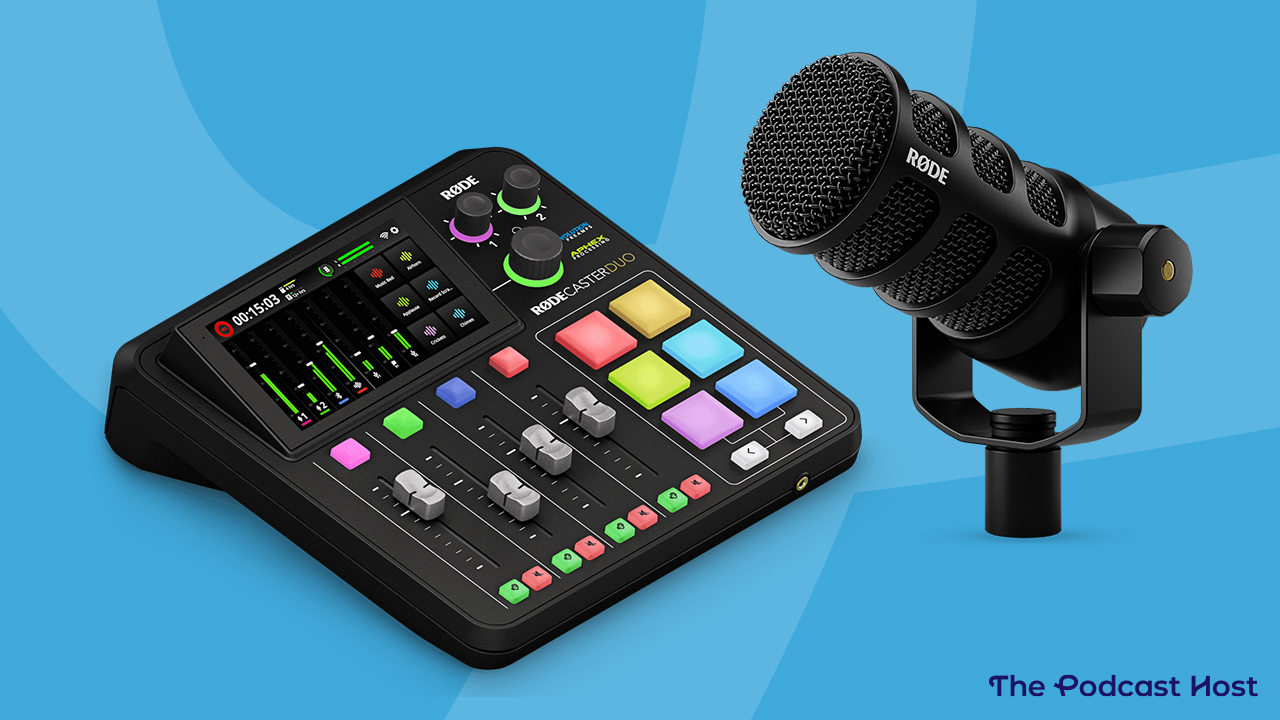
I’ve been really interested in some of Rode’s new podcaster/streamer-specific offerings. Their approach seems designed to cater to both experienced and beginner podcasters, and the two pieces of equipment I’m reviewing today, the PodMic USB and the Rodecaster Duo, demonstrate this idea.
Both are slightly more expensive than the usual entry-level options:
…but not so expensive to be considered fully professional (whatever that means).
Quick heads up that we use affiliate links to help support all our free content!
Most importantly, both bits of kit feature the word ‘pod’ and/or ‘caster’ in the name, following on from the Boss Gigcaster and the Joby WavoPod (see also the Zoom PodTrak P4 and the Maonocaster E2 – ed), making it absolutely clear who the target audience is. Musicians and sound recordists need not read on; this is not for your eyes and/or ears. This one’s for the podcasters!
Rodecaster Duo Review
The Rode Rodecaster Pro II is the big dog of all-in-one podcast recorders. But few podcasters need four XLR inputs to record their show. With this in mind, Rode has also created the Rodecaster Duo which is a downsized version of the Rodecaster Pro II, optimal for recording with one guest or co-host.
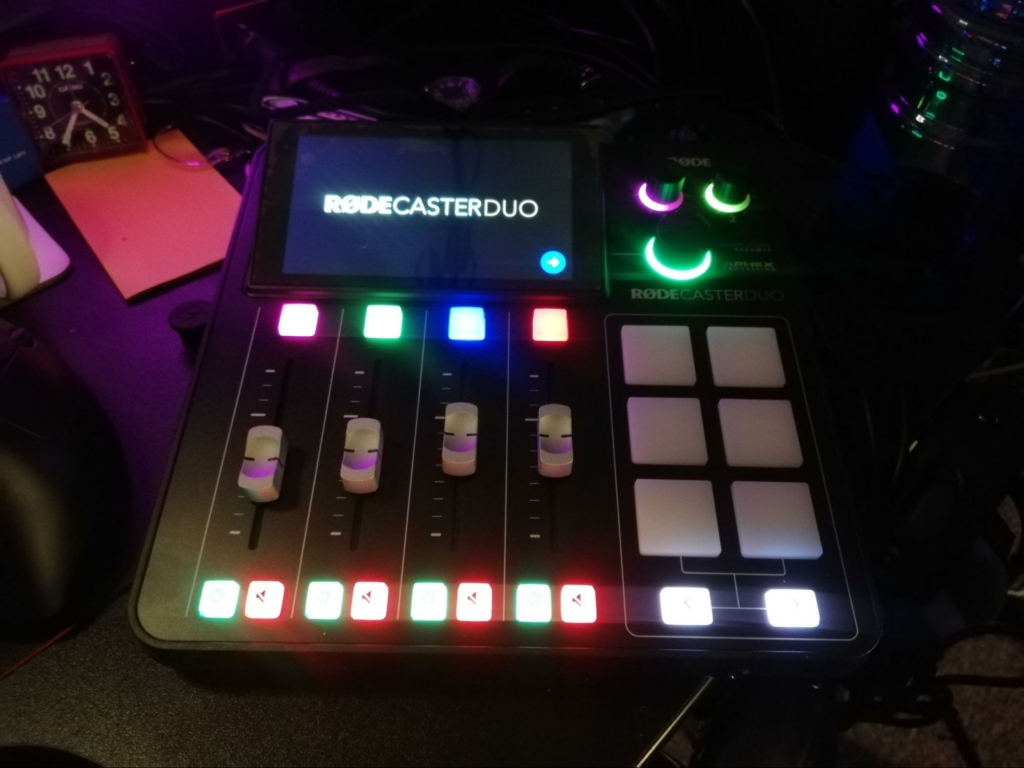
The Rodecaster Duo is billed as ‘the ultimate compact audio solution for podcasters and content creators’, and upon initial inspection, it’s easy to see why.
Rodecaster Duo Features
It may be downsized in comparison to the Rodecaster Pro II, but it’s far from limited. You can still record up to seven audio tracks on the Rodecaster Duo.
The Duo features two combined mic/line inputs, as well as a TRRS jack for a headset, a stereo mix output, and two headphone jacks.
On the Rodecaster Duo, you’ll also find a six-pad soundboard, four faders, built-in recording capability to micro-USB or multiple external devices, and Bluetooth connectivity.
Switching on the unit leads to more surprises. It vibrates when you turn it on (deeply unsettling), and you can connect it to WiFi! Typing in my WiFi password also revealed to me that the touchscreen is responsive and quite comfortable (though I left the screen cover on so TPH doesn’t have to answer for my mucky paws).
There’s a setup wizard (complete with wizard hat) to guide you through the initial process, and it also functions as a sort of tutorial level that continues to demonstrate more features.
Headphone levels are indicated by a band of light around the dial, and it has presets based on what kind of microphone you have plugged in. There was a specific preset for the PodMic USB, which was handy!
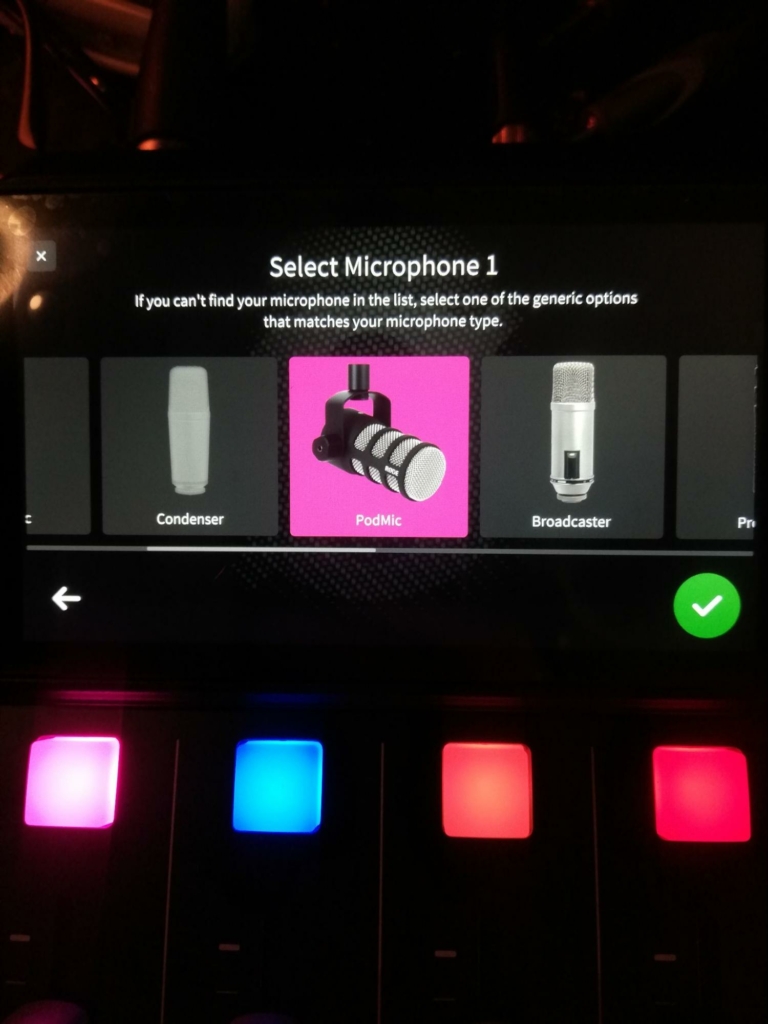
Rodecaster Duo Vs Boss Gigcaster 5
In my experiments with the Duo, the only real point of comparison I had was the Boss Gigcaster 5, which I use for my live shows.
The Gigcaster 5 is not as expensive as the Duo (around $480) but comes with more inputs and effects, along with many of the features included in the Duo (multiple headphone outs, Bluetooth connectivity, sound pads).
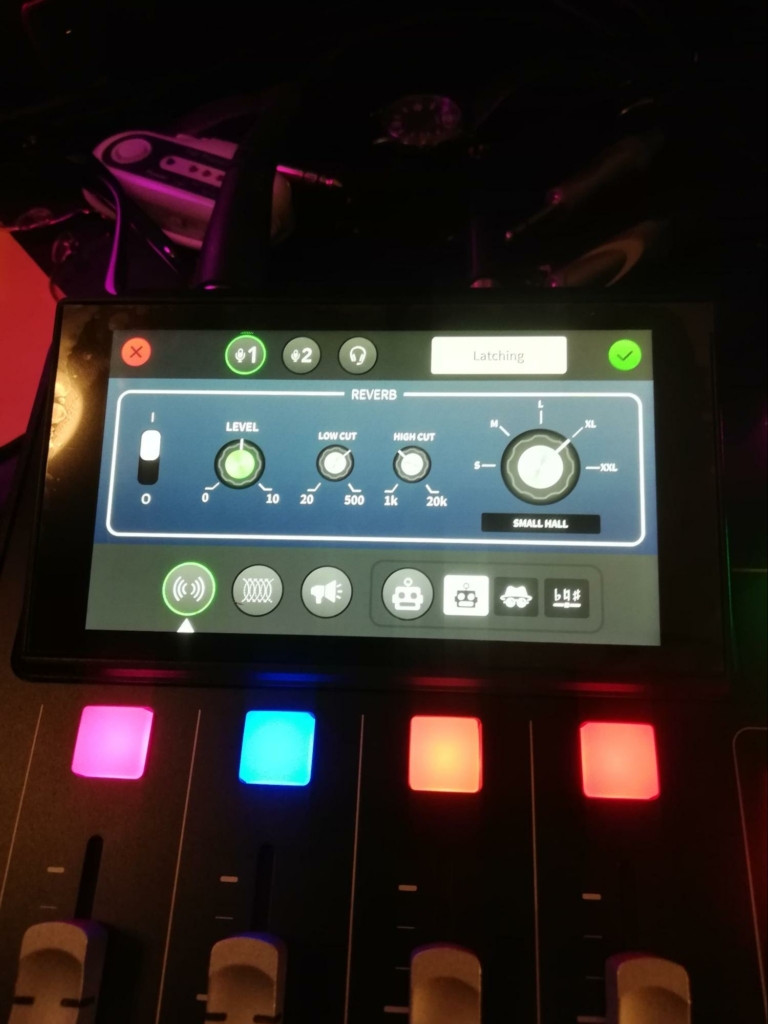
I found the Duo much more straightforward to figure out, especially when it came to the integrated effects that can be mapped to the sound pads. The Duo presents these as a set of dials like an effects pedal or an amp rather than the series of menus and sliders on the Gigcaster, though the Gigcaster comes with more options. I really like how the Duo saves settings as ‘shows’ that can be exported or imported, and it also has onboard recording capability, while the Gigcaster 5 does not.
Despite both products featuring the word ‘caster’ in their respective names, the Gigcaster is more geared towards musicians and, while the Duo does support line inputs, which it denotes with a little guitar symbol, the Rodecaster Duo is more targeted towards podcasters and talk radio/streaming.
Summing Up The Rodecaster Duo
I really enjoyed my time with the Rodecaster Duo. It’s sleek, it’s intuitive, and I had more options than I knew what to do with. It integrated seamlessly with the PodMic USB (almost as if they were designed by the same company) and the combination felt like a little mobile podcasting powerhouse.
I think the Duo would work brilliantly as a travelling podcast studio for those of us who do conventions or live shows. The inbuilt voice effects and soundboard would be useful for streamers, too. It would also work really well as an in-studio audio interface, giving you tactile control over your inputs.
If you’re a podcaster looking for a mixer, the Rodecaster Duo is a great choice, with a few caveats:
- If you want something that’s simple to use, gives you some options to play and experiment with, but doesn’t overwhelm you with technical stuff to figure out.
- If you’re prepared to fork out a decent chunk of cash – remember, you’ll still need to buy at least one mic, too!
And speaking of mics, let’s take a look now at the Rode PodMic USB…
Rode PodMic USB
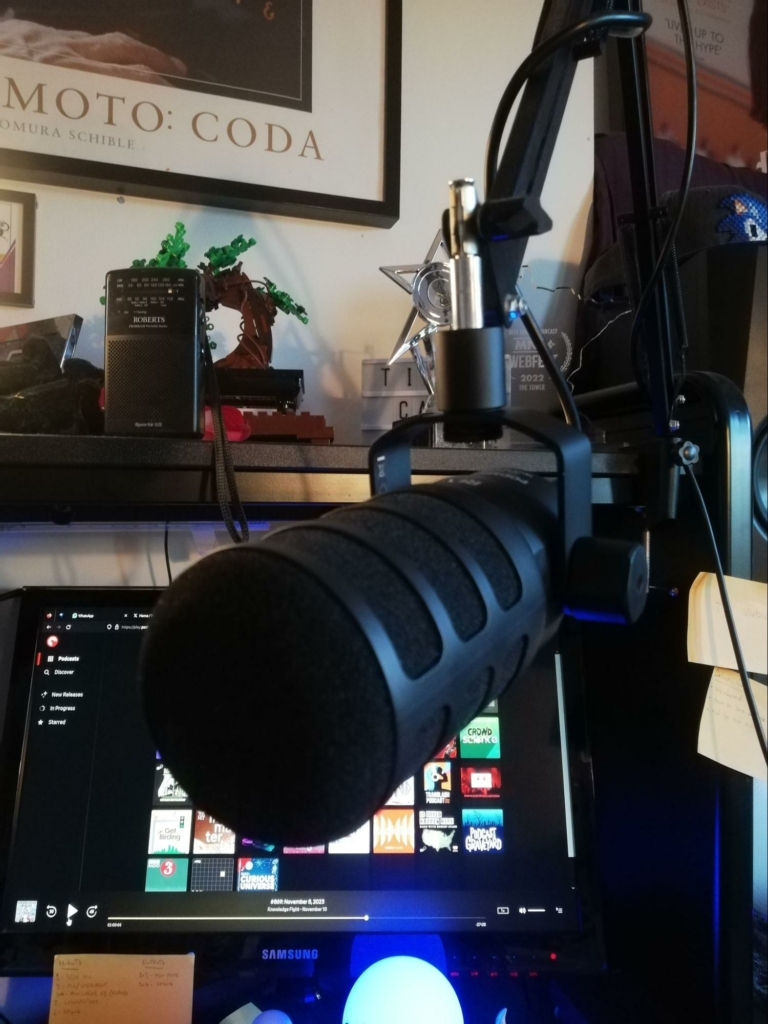
The Rode PodMic USB is a dynamic broadcast microphone for ‘podcasting, streaming, gaming, voice overs, and other speech applications for content creation’, which is a long-winded way of saying it’s for recording speech rather than singing.
It’s a somewhat squat design for a broadcast microphone; it’s missing the familiar big back end of the more expensive broadcast mics out there. However, it’s a lot heavier than it looks, and I was a little bit worried about having it on my desk arm for an extended period of time.
Speaking of my desk arm, the PodMic USB comes with its own swing mount, meaning I could integrate it into my desk setup immediately.
The big thing that I love about this mic is that it supports both USB and XLR connectivity. I’ve reviewed a couple of USB mics, and as a podcaster, I recognise how important they are in making the space accessible to beginners and people looking to dip their toe in the murky waters of this industry. As an audio professional, however, I sometimes find it difficult to honestly review them, as I came to podcasting from music and had spent a lot of time (and money) learning how to record with interfaces and XLR mics.
My honest opinion is that if you’re serious about podcasting or voice-over work, it’s a better investment to get yourself an audio interface and a non-USB microphone and learn how they work. You’ll get better audio and better jobs (and also, it just looks cooler).
Thankfully, the Rode PodMic USB allows you to start recording with USB and, should you find you actually quite like this talking into a microphone business, you can keep on using it after you upgrade to an audio interface (and it also looks cool).
In terms of sound, the PodMic USB (if you’re getting fed up reading that, by the way, imagine how I feel writing it) comes with all the pros and cons of a dynamic microphone. There are some excellent, very grown-up guides on the subject on this very website, so I won’t go into it too much, but I would recommend using a preamp if you are recording via XLR, otherwise, you will be turning your gain up on your interface to the part of the dial labelled ‘risky’.
The plus side is that you get that lovely warm, punchy sound that has become the standard for podcasts and streamers, no doubt attenuated by the ‘Ultra-low-noise, high-gain Revolution Preamp™’.
For USB recordings, the PodMic USB has a headphone jack on the bottom, as well as an adjustable gain wheel. The gain wheel doesn’t have set limits, making it difficult to have a definitive idea of what the gain setting actually is. This is a problem I’ve found with a number of USB mics, and it was disappointing to find it here.
Overall, I really liked the PodMic USB. It has all the bells and whistles of a professional recording microphone with the added flexibility of using it both as an XLR and a USB microphone (I cannot stress enough how brilliant I think this is as a feature). It is a bit more expensive than some of the other offerings out there, but I think it’s justified in that you’ll get more out of the PodMic USB than a cheaper USB-only mic.
For the professional podcaster, I can absolutely see this as a microphone that can be sent to prospective guests for remote recording sessions. This is due to its ease of use while also doubling as an additional dynamic microphone for the studio (because of, you guessed it, the fact that it’s both USB and XLR, did I mention that?).
Conclusions: Rodecaster Duo & Rode PodMic USB Review
My overall feeling after reviewing both of these products was that Rode are trying a little bit to do the Apple thing; they want you to use their products and only their products. The Duo has specific settings for specific Rode microphones, otherwise you have to make do with a generic mic-type setting (‘Broadcast’, ‘Condenser’, etc.). The inside of the Duo box recommends a specific set of Rode headphones, a specific Rode microphone, and a specific Rode desk arm to attach it to.
I get that, to a certain extent. This is just companies being companies, and Rode does make good equipment. I’ve had an NT1-A attached to my desk for years, I even bought a second one recently. But I feel like, especially with the Duo, that these products are targeted towards people who know that Rode makes good equipment and are willing to spend more on something made by them without really taking the time to learn what else is out there.
These products are slick, they light up, they look good and, to be absolutely clear, they are really great. But in terms of actually getting the job done, there are other products that aren’t as pretty that will get you the same results for less of a hit on your bank balance.
Check out the Rode PodMic USB and Rode Rodecaster Duo on Amazon. Or, if you’d still like to do some shopping around, click through to our full podcast equipment guide!
